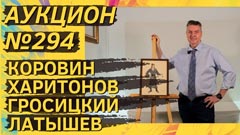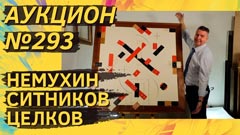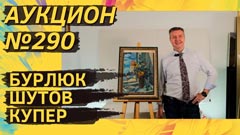
MASTERPIECES
KALININ Vyacheslav Vasilievich (1939) A beer bar in Serpukhov. Evening. 2003. Oil on canvas. 130 × 100
Before us is a picture from the book “Nonconformists” by Natalia Sinelnikova. “A beer bar in Serpukhov” by Vyacheslav Kalinin, from page 534. It's a warm evening. People are resting. Drinking beer with crayfish. In the man with trays in his hands we can guess the image of Vladimir Nemukhin, a friend and neighbor from Priluki. And the resemblance is probably not accidental, because the painting was painted just in Priluki.
Vyacheslav Kalinin is a man of the sixties, an artist of unofficial art from the Lianozovo circle. Until the mid-1970s, his exhibition halls were mostly the apartments of diplomats and enthusiastic friends. One of his more high-profile exhibitions was the Beekeeping Pavilion at VDNKh in 1975. After the founding of the City Committee on Malaya Gruzinskaya Street, he participated in the exhibitions of the “Seven” group along with Nemukhin, Krasnovtsev, and Plavinsky, and later was a member of the “Twenty”.
Kalinin created his own very recognizable style, which has been called “carnivalism” — from the word carnival. Very aptly. Kalinin's characters are almost always fun. The regulars in his paintings are broken ladies, drunkards, and cheerful artist friends. His works are very moody, phantasmagoric, with elements of cubist deconstruction. And “A beer bar in Serpukhov” — a model example of the genre. A large, powerful painting. Published. The main theme. A jewel in the collection.
1960s UNOFFICIAL ART
SCHWARTZMAN Mikhail Matveevich (1926–1997) Hierature. 1970. Paper, tempera. 77 × 54
Mikhail Schwartzman was one of the most brilliant innovators of post-war abstract expressionism and the creator of the philosophy of hieratic art (from the Greek “hieratos” — sacred).
At the end of the war he was a sapper, was seriously wounded, blew up on a mine. He demobilized in 1950, entered the Stroganov Institute, studied with Pavel Kuznetsov (from the association “Blue Rose”), studied ancient Russian art. In 1963 he won the first prize at the All-Union competition of monumental art for the panel on the MIFI building. Then, as you know, he occupied the post of chief designer at the Special Art and Design Bureau of the Ministry of Light Industry, designed trademarks and formed the Schwartzman Group.
Keeping it simple, Schwartzman's idea was that the artist should listen attentively to the signs sent from above. The important thing was not to be distracted by extraneous beauty, but to wait for real inner illumination and act on instinct. This inner intellectual and mystical work of Schwartzman resulted in powerful, complex abstractions — multi-piece, painted with profound respect for the traditions of Russian icon-painting. Some see in his hieratures an image of portals connecting worlds. One might say that Schwartzman did not paint, but rather grew his abstractions layer by layer, like crystals. Schwartzman described this complex layering of tempera as a “change of metamorphosis”. Schwartzman's philosophical quests aroused the interest of daring Soviet collectors as early as the 1960s. Costakis, in particular. He was not the only one. It was, however, difficult to come to an agreement with the hierat, who almost never sold anything to anyone. He refused. And if they insisted, he called deliberately fabulous figures. For example, when Costakis asked to sell him something, Schwartzman named the figure of $ 100,000. Moreover, he advised Costakis to sell his Kandinsky in order to raise the money. Today, $ 100,000 for a painting by Schwartzman is an ordinary price. Back then, it was a fantastic sum. Well, in theory, the artist could afford to tease Costakis like that. He was not in dire need of money. Schwartzman earned well in book illustration and, from the mid-1960s, worked as head designer at the design bureau, designing trademarks for Soviet industry. The rest of his time was spent on his art, his students, his school and his spiritual quests. Not only did Schwartzman not sell his works, he also refused to exhibit them for a long time — he only showed them to a circle of trusted friends. His first exhibition was held at the City Committee of Graphic Arts on Malaya Gruzinskaya Street in 1983. A small pool of his independent works became available on the art market only after the artist's death, in the early 2000s. They are still a great rarity. Every appearance of Schwartzman's works on sale is an event for collectors.
Our tempera is simply called “hierature”. Schwartzman did not like to give titles and even stated that “hierature cannot be named verbally”. Sometimes, however, he made concessions to art critics, so as not to be confused at exhibitions. Conventional figurative names such as “Chain” or something else appeared. The work is signed not only on the front side — М Ш М (Mikhail Matveyevich Schwartzman) — but also on the reverse. There is also the date: 1970. The hierature was purchased at Sotheby's, at a high-profile nonconformist auction in October 2020. It was previously in the collection of a German collector who acquired it in 1993.
KRASNOPEVTSEV Dmitry Mikhailovich (1925–1995) Monument. 1968. Oil on canvas. 29 × 24
This painting by Dmitry Krasnopevtsev comes from the collection of the famous collector Igor Sanovich. A small laconic still life belongs to a particularly valuable period, which begins in 1961. The painting is signed and dated from the back. The authenticity is confirmed by the expert opinion of Valery Silaev.
ZVEREV Anatoly Timofeevich (1931–1986) Gold of Moscow churches. Graphic improvisation. 1984. Lead pencil, watercolor on paper. 21 × 16
Expert Valery Silaev notes that this is not an original landscape, but a momentarily improvised work. The watercolor is brilliantly rendered in a vividly decorative manner. The expert writes that there is a sense of scale and monumentality in this small piece of paper, as if it were a sketch of a decorative panel or an exquisite tapestry. The drawing is signed in the upper right corner. There you can find the signature abbreviation in graphite pencil АЗ and the date 1984.
VULOKH Igor Alexandrovich (1938–2012) Field 3. 2012. Plate. Porcelain, hand-painted. Diameter 32 cm
The series of plates “Fields” appeared during the lifetime of Igor Vulokh (1938–2012) in 2010. And in 2013 it was presented at his retrospective at the Moscow Museum of Modern Art. It is a small series. Three plates were issued in an edition of 20 copies. And the fourth, with poems by Gennady Aygi, only 10 copies. That is, in front of us is a rarity. 3/8 is not an edition, but a catalogue number.
The series is based on Vulokh's illustrations of the poems of Swedish poet and Nobel laureate Tumas Tranströmer. Vulokh made them in 1994. Tranströmer liked them. And he saw them live at an exhibition in Moscow, organized in honor of his 70th birthday.
Each plate was painted by hand by porcelain artist Boris Kalita.
Igor Vulokh is an artist of unofficial art of the 1960s. His works are in the collections of the country's major museums and important private collections, including those of the Semenikhins, Alshibai, Kurtzer, and others.
Vulokh's plates from the “Fields” series are published in the famous collection “Porcelain of the Sixties”. The plate is packed in a gift box and provided with a certificate signed by the artist.
- Log in to post comments










